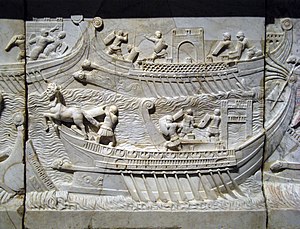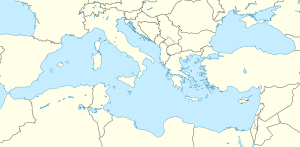| Battle of Actium | |||||||
|---|---|---|---|---|---|---|---|
| Part of the War of Actium | |||||||
 Detail of the naval battle from an early 1st-century relief commemorating Actium (extensively restored) | |||||||
| |||||||
| Belligerents | |||||||
| Octavian's forces |
Antony's forces Ptolemaic Egypt | ||||||
| Commanders and leaders | |||||||
|
Octavian Marcus Agrippa Lucius Arruntius Marcus Lurius |
Mark Antony Gaius Sosius Lucius Gellius Cleopatra | ||||||
| Strength | |||||||
|
250–400 galleys 3,000 archers 16,000 infantry on ships[1][2][3] |
250–500 larger galleys 30–50 transports 20,000–70,000 infantry on ships 2,000 archers[1][2][3] | ||||||
The Battle of Actium was a naval battle fought between Octavian's maritime fleet, led by Marcus Agrippa, and the combined fleets of both Mark Antony and Cleopatra. The battle took place on 2 September 31 BC in the Ionian Sea, near the former Roman colony of Actium, Greece, and was the climax of over a decade of rivalry between Octavian and Antony.
In early 31 BC, the year of the battle, Antony and Cleopatra were temporarily stationed in Greece. Mark Antony possessed 500 ships and 70,000 infantry, and made his camp at Actium, and Octavian, with 400 ships and 80,000 infantry, arrived from the north and occupied Patrae and Corinth, where he managed to cut Antony's southward communications with Egypt (via the Peloponnese) with help from Marcus Agrippa. Octavian previously gained a preliminary victory in Greece, where his navy successfully ferried troops across the Adriatic Sea under the command of Agrippa. Octavian landed on mainland Greece, opposite of the island of Corcyra (modern Corfu) and proceeded south, on land.
Trapped on both land and sea, portions of Antony's army deserted and fled to Octavian's side (daily), and Octavian's forces became comfortable enough to make preparations for battle.[4] Antony's fleet sailed through the bay of Actium on the western coast of Greece, in a desperate attempt to break free of the naval blockade. It was there that Antony's fleet faced the much larger fleet of smaller, more manoeuvrable ships under commanders Gaius Sosius and Agrippa.[5] Antony and his remaining forces were spared only due to a last-ditch effort by Cleopatra's fleet that had been waiting nearby.[6] Octavian pursued them and defeated their forces in Alexandria on 1 August 30 BC—after which Antony and Cleopatra committed suicide.
Octavian's victory enabled him to consolidate his power over Rome and its dominions. He adopted the title of Princeps ("first citizen"), and in 27 BC was awarded the title of Augustus ("revered") by the Roman Senate. This became the name by which he was known in later times. As Augustus, he retained the trappings of a restored Republican leader, but historians generally view his consolidation of power and the adoption of these honorifics as the end of the Roman Republic and the beginning of the Roman Empire.[7]
- ^ a b Lendering, Jona (10 October 2020). "Actium (31 BCE)". Livius.org. Retrieved 16 October 2020.
- ^ a b Kellum, Barbara (September 2010). "Representations and Re-presentations of the Battle of Actium". Oxford Scholarship Online. pp. 187–203. doi:10.1093/acprof:oso/9780195389579.003.0012. ISBN 978-0-19-538957-9. Retrieved 16 October 2020. doi:10.1093/acprof:oso/9780195389579.003.0012
- ^ a b Migiro, Geoffrey (31 December 2017). "What Was the Battle of Actium?". WorldAtlas. Retrieved 16 October 2020.
- ^ Eck (2003), 37.
- ^ Eck (2003), 38.
- ^ Eck (2003), 38–39.
- ^ Davis, Paul K. (1999). 100 decisive battles: From ancient times to the present. New York: Oxford University Press. p. 63. ISBN 978-0195143669. OCLC 45102987.


